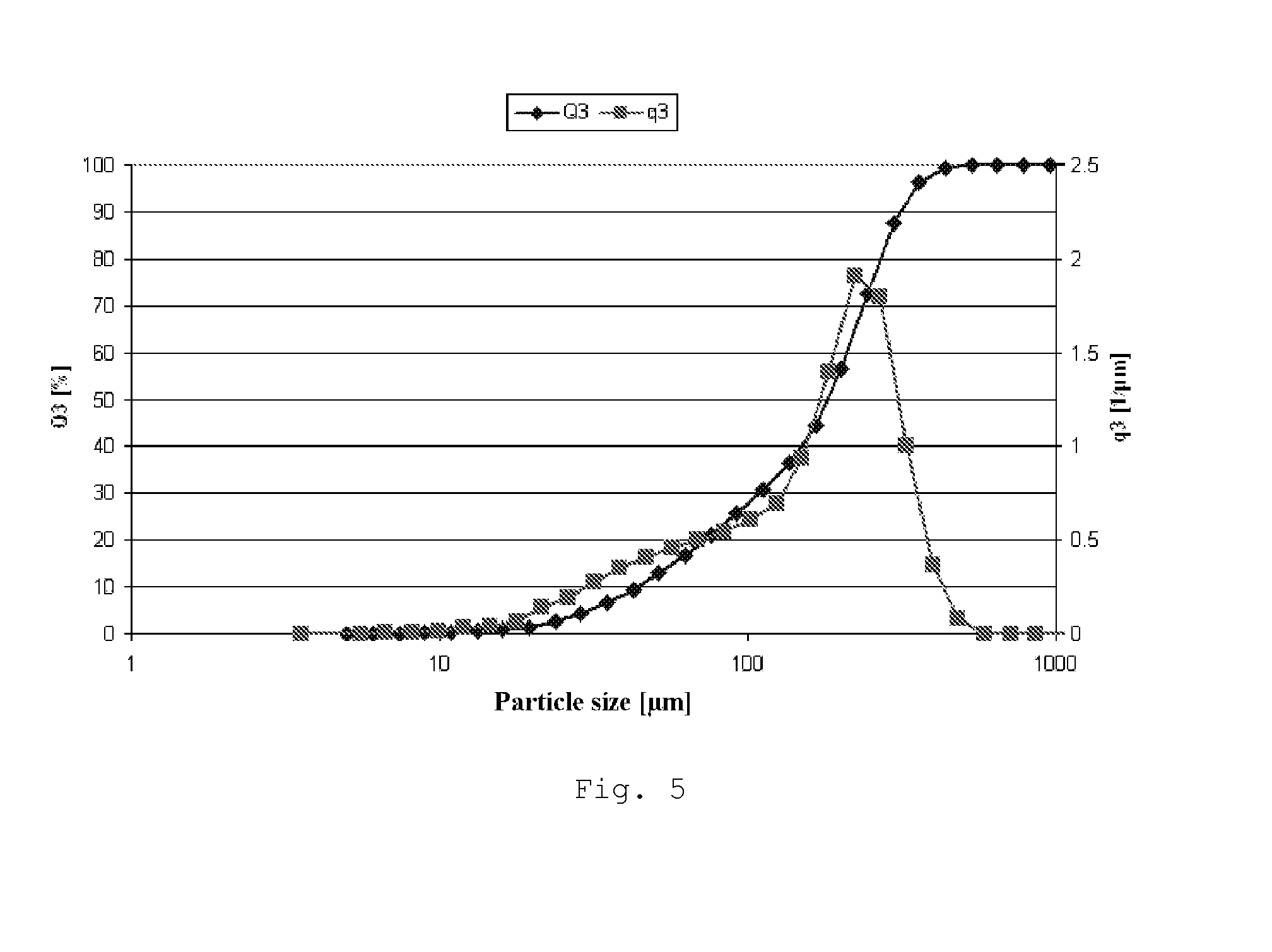L-amino-acid-containing feed additive in the form of fermentation-broth-based granules, and processes for its preparation
a technology of amino acid-containing feed additive and fermentation-broth-based granule, which is applied in the field of laminoacidcomprising feed additive in the form of fermentation-broth-based granule, can solve the problems of complex composition of such media, risk of agglomeration, and inability to flow, so as to achieve better hydrothermal stability and better homogeneity of compound feeds
- Summary
- Abstract
- Description
- Claims
- Application Information
AI Technical Summary
Benefits of technology
Problems solved by technology
Method used
Image
Examples
example 1
[0122]A fermentation vessel equipped with stirrer and aerating system was charged with 150 kg of a sterile solution of the following composition:
TABLE 1.1ConstituentAmountWater130lGlucose12.4kgMaize gluten9.0kghydrolysate, sulphuricAmmonium sulphate1.5kgMineral salts,0.4kgtrace elementspH (adjusted with7.5ammonia solution)
[0123]This solution was treated, at 33 to 35° C., with 12 l of an inoculum of an L-lysine-producing Corynebacterium which had been grown in the same fermentation medium, but in a separate fermentation vessel. Within 40 hours, 77 l of a sterile solution which, before being neutralized to pH 7.5, had the following composition:
TABLE 1.2ConstituentAmountWater38lGlucose40.0gMaize gluten8.3kghydrolysate, sulphuricAmmonium sulphate0.9kgAntifoam (Nalco ®)0.08kgMineral salts,0.2kgtrace elements
[0124]During the entire fermentation period, the pH was maintained at between 7.0 and 7.5, using ammonia solution. The stirrer speed was set to 600 rpm and...
example 2
Granulation of the Concentrated Fermentation Product
[0129]A fluidized-bed granulation dry unit, equipped with a gas distributor plate of diameter approx. 400 mm and two-blade fan of diameter 150 mm, integrated into the fluidized bed, was charged with 30 kg of granules as the initial charge. The fan was operated at a circumferential speed of 20 m / s. The fluidized bed was charged with hot air of approximately 210° C. as drying and fluidizing agent, and the concentrate of the lysine fermentation of Example 1 was injected continuously via a two-substance nozzle at approximately 60 kg / h. After approximately 4 to 5 hours, a stationary operating state was reached, and granules with the following product parameters were discharged continuously.
[0130]The product properties of granules obtained in a steady-state procedure are compiled in Table 2.1.
TABLE 2.1Moisture 3%Bulk density690 kg / m3Tamped density710 kg / m3Particle size distribution10% by wt. 50% by wt. 90% by wt. Abrasion0.2%Erweka fria...
example 3
Adjustment of the Particle Size
[0133]To adjust the particle size of the granules obtained in Example 2, 200 kg of the granules were placed into a roll-type crusher from Merz Aufbereitungstechnik, type Kleinmahlanlage WPB 2 / 3. The unit was equipped with a feeding funnel, vibroconveyor and a discharge tube.
[0134]For the grinding, the milling gap was set at 0.2 to 0.3 mm. The rollers employed were used rollers, so that the milling gap in the central zone of the roller was 0.3 mm and in the outer zones of the roller 0.2 mm. The differential speed of the rollers was set at 0.5, which means that one roller rotated at twice the speed of its counter roller. The rollers employed had a smooth surface without profile. The feed rate was set at 65 kg / h and the roller speed at 8 m / s (roller No. 1) and 2 m / s (roller No. 2).
[0135]The granules obtained were checked for their particle size (Example 4).
PUM
| Property | Measurement | Unit |
|---|---|---|
| particle diameter | aaaaa | aaaaa |
| molar ratio | aaaaa | aaaaa |
| particle size diameter | aaaaa | aaaaa |
Abstract
Description
Claims
Application Information
 Login to View More
Login to View More - R&D
- Intellectual Property
- Life Sciences
- Materials
- Tech Scout
- Unparalleled Data Quality
- Higher Quality Content
- 60% Fewer Hallucinations
Browse by: Latest US Patents, China's latest patents, Technical Efficacy Thesaurus, Application Domain, Technology Topic, Popular Technical Reports.
© 2025 PatSnap. All rights reserved.Legal|Privacy policy|Modern Slavery Act Transparency Statement|Sitemap|About US| Contact US: help@patsnap.com



